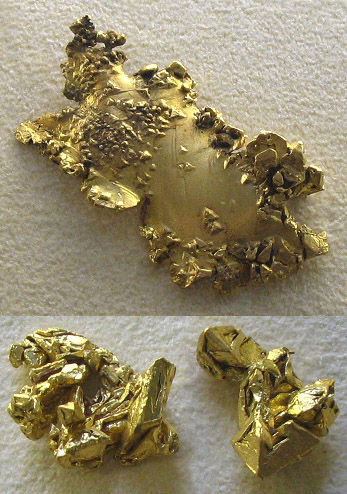 |
| Gold Nuggets |
Geologists consider Metasomatism as the chemical alteration
of rock by hydrothermal
or other fluids that can come from either an igneous or metamorphic
source.
If it was caused by the action of magma intrusions or
volcanic activity Metasomatism
makes skarns, greisens and may also affect hornefels if there is a contact
metamorphic aureole next to the intrusive magma. In a metamorphic environment it takes the
mass transfer of liquid from a mass of hot rock that has water driven from it
by the action of metamorphism with the water or other fluids acting as a
solvent.
This occurs whenever rocks buried in the deep
crust are losing fluids (dewatered) as well as dissolved mineral components
because of the breakup of hydrous
minerals. The fluid with its
dissolved minerals percolate to the near surface and in some circumstances
reach the surface as springs of juvenile water.
The action of this hot water can chemically alter and change the crustal
rocks.
It is this mechanism that tells us that metasomatism is an
open system that is different from the usual metamorphic process
causing an in situ mineralogical change in a rock, but does not alter the
chemistry of the rock. In effect
metamorphism and metasomatism go to gather like hand and glove.
In practice metasomatism is in reality a mass transfer process
that is best shown by gold ore deposits that are the result of the focused
concentration of gold bearing metasomatic fluids. These fluids drop their load of dissolved
gold in shear zones and lodes. Often the
first indicators of gold are altered rock.
It is this mechanism that removes gold from greenstone and deposits it
in adjoining rock.
This fluid is extracted from many cubic kilometers of rock
where the overall content of gold can be quite sparse yet it is concentrated in
the host
rock. One common example of this is
the so-called saddle reef where gold is concentrated at the nose of a vertical fold where
sometimes a large quantity of gold occurs in a small deposit. Another type of deposit is illustrated by the
Carlin Trend in Nevada
where the action of metasomatism has caused the depositing of gold throughout a
massive formation of limestone.
In order to be affected by metasomatism it is necessary for
the rocks to be permeable to water. Some
of the other minerals formed by this mechanism beside gold are: copper, iron,
molybdenum lead, zinc and tin. Some of
the industrial
minerals formed are: graphite, mica, talc and wollastonite.
Because the fluids are moving through permeable rock one of
the best places to look for gold is where one rock type contacts another. That area acts as a dam for holding the
mineral laden water in place where it deposits its mineral load.

Great Article
ReplyDeleteGold Mining
Bullion Exchanges is a reputable Precious Metals Shop established in the heart of New York City's Diamond District.
ReplyDeleteThey have a wide variety of items like, bullion that range from the popular gold & silver to platinum & palladium.
They are offering an enormous selection of products appealing to first time shoppers and the established collectors.